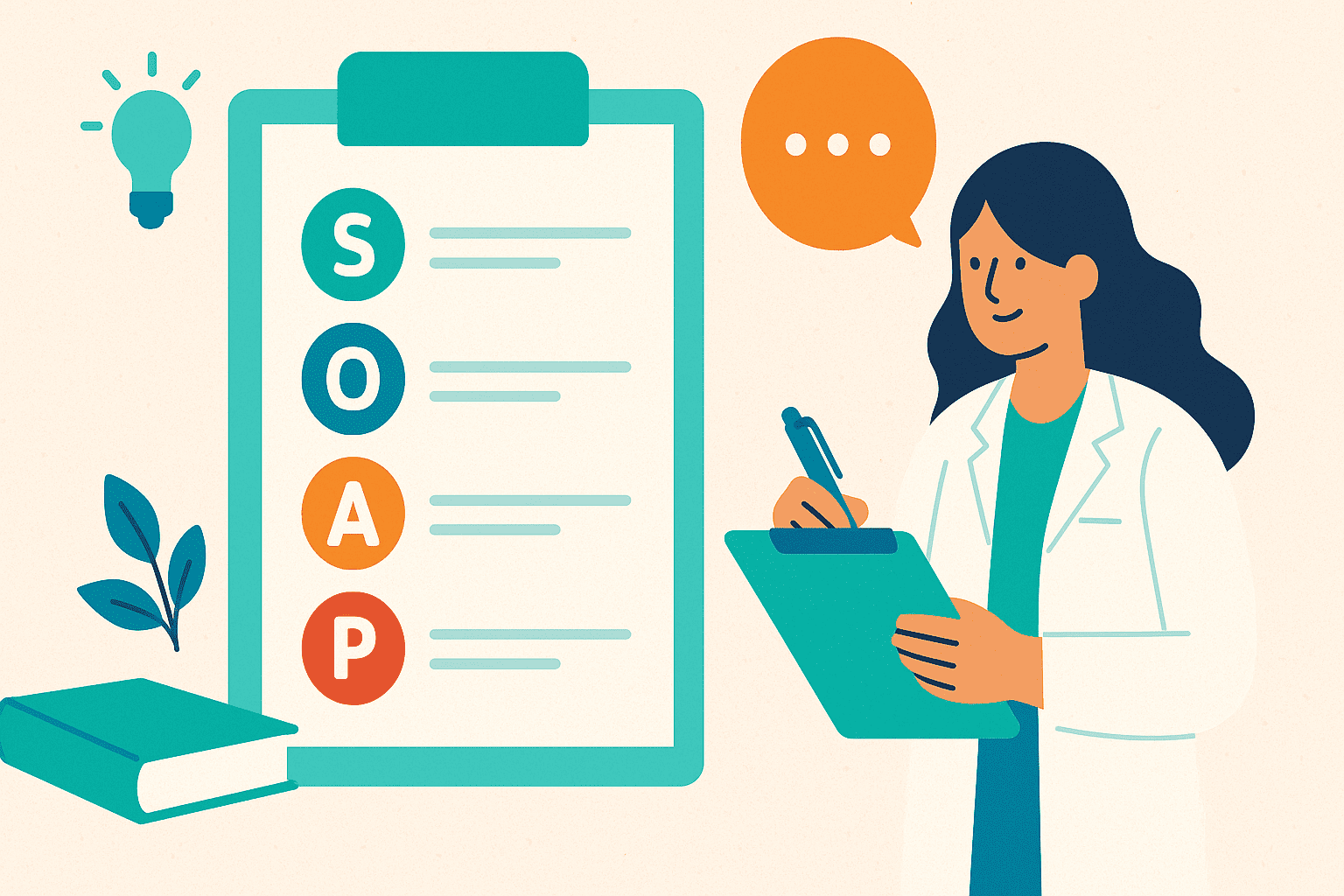Updated on: September 11, 2025
Click here to access and download the SOAP note template
Click here to access and download the SOAP note template
Enter your email to access this resource.
SOAP notes—Subjective, Objective, Assessment, Plan—form a foundation of clinical documentation across healthcare disciplines. Rooted in the 1950s by Lawrence Weed and refined in medical education and practice, SOAP notes remain a gold standard for clear, organized, multidisciplinary records.
What Is a SOAP Note?
Definition & Origins
- SOAP stands for:
S = Subjective info (patient-reported)
O = Objective data (clinician-observed/measurable)
A = Assessment (clinical interpretation)
P = Plan (next steps/treatment) - Conceived as part of the Problem-Oriented Medical Record methodology
- Universally adopted across physicians, therapists, counselors, OTs, PTs
Why It Matters
- Enhances clarity in documentation
- Streamlines interdisciplinary collaboration
- Supports insurance billing and audit compliance
- Protects legally with structured record-keeping
Deep Dive: Section-by-Section Breakdown
Subjective (S)
Contains the patient’s narrative—chief complaints, descriptions, quotes.
What to include:
- Chief Complaint (CC) with direct quotes
- History of Present Illness (HPI): onset, duration, severity, modifiers
- Contextual details: living situation, medication changes, psychosocial notes
Common Pitfalls:
- Avoid clinician’s unqualified opinions — attribute statements to the patient or observers
Example:
“I’ve had this nagging hip pain for two weeks; it’s a 6/10, especially when I walk upstairs,” reported by the patient.
Objective (O)
Clinician-observed, quantifiable findings.
What to include:
- Vital signs
- Physical exam results (range-of-motion, gait)
- Mental status exam, standardized assessments (PHQ‑9, GAD‑7)
Tips:
- Be concise, factual, measurable
- Distinguish signs (what you observe) from symptoms
Example:
- “Hip internal rotation limited to 30° bilaterally; Trendelenburg gait present; GAD-7 scored at 18 (severe anxiety).”
Assessment (A)
Clinician’s analysis, diagnostic impressions, and progress interpretation.
What to include:
- Differential or confirmed diagnosis (DSM‑5 aligned)
- Interpretation of S/O findings
- Progress toward goals or new clinical concerns
- Avoid repeating raw data; synthesize insights
Example:
- “Findings consistent with trochanteric bursitis causing functional limitation; anxiety remains severe, consistent with GAD worsening under stress.”
Plan (P)
Clearly defined next steps—treatment, referrals, homework, scheduling.
What to include:
- Frequency and duration of therapy or follow-up visits
- Therapeutic interventions (manual therapy, CBT, mindfulness)
- Referrals (e.g., psychiatrist for medication eval)
- Client homework / self‑management tasks
Avoid:
- Repetition of Assessment data
- Vague language like “continue plan” — be specific
Example:
- “Refer to orthopedist for imaging; initiate CBT-based stress management; teach hip strengthening routine; weekly PT for six weeks.”
Best Practices & Common Pitfalls
Stay Timely & Concise
- Document within 24 hours of session
- Use past tense and clinical language
Be Specific & Data-Driven
- Include hard numbers, e.g., “improved from 2 to 4/10 pain”
- Distinguish clearly between objective data and clinician interpretation
Use Standardized Tools
- Document assessment scores (PHQ‑9, GAD‑7, VAS) to track progress
Maintain Confidentiality
- Comply with HIPAA/security measures for sensitive data
Discipline-Specific Nuances
| Profession | SOAP Focus Highlights |
|---|---|
| Physicians | Vital signs, labs, imaging, differential diagnoses |
| Physical Therapists | ROM, gait analysis, MMT, functional mobility |
| OTs | ADL performance, fine motor progress |
| Counselors | Mental status, behavioral observations |
| SLPs | Speech/articulation metrics (e.g., 17/25 correct) |
Real SOAP Note Examples
Example 1: Physical Therapy for Hip Pain
S: “My hip pain is 5/10 yesterday, 6/10 today upstairs.”
O: Trendelenburg gait, 20° loss of internal rotation, pain with palpation of TFL.
A: Likely left trochanteric bursitis; consistent with exam findings.
P: Begin PT weekly × 6 weeks, hip-strength HEP, reevaluate; refer if no improvement.
Example 2: Counseling / Mental Health
S: “I can’t calm down at night; the worry keeps me awake,” reports client.
O: Appears restless, speech rapid, GAD‑7 score = 18.
A: Severe anxious symptoms consistent with Generalized Anxiety Disorder exacerbation.
P: Initiate CBT focus and progressive muscle relaxation, weekly sessions, provide PHQ‑9 & GAD‑7 at next visit.
Common Mistakes to Avoid
- Unattributed claims in S: Must cite patient or caregiver
- Objective lacks data: “Appeared upset” is vague — quantify
- Re-stating instead of evaluating in A: No direct copy-paste from S/O
- Vague Planning: Must specify next steps clearly
Enhancing SOAP Notes with Templates & Tech
- EHRs (e.g., SimplePractice) provide templates, score trackers, and prompts
- Use checkboxes, dropdowns to speed documentation
- Store templates for repeatable efficiency
Additional Resources
- Guidance on writing SOAP treatment plans
- Discipline-focused guides: PT , Counseling , OT
- Common mistakes – how to avoid them
Visual Quick-Reference Chart
| Component | Content | Key Tip |
|---|---|---|
| S | Patient’s words | Direct quotes, context, CC |
| O | Measurable signs | Vitals, objective tests, behaviors |
| A | Clinician interpretation | Diagnostic impression, hypotheses |
| P | Specific next steps | Referrals, freq., modifiable tasks |
Bringing It All Together
- Consistently apply the SOAP structure – don’t skip sections.
- Be data-driven and concise – quantify, cite patient quotes, avoid redundancy.
- Align documentation with treatment goals – ensure clarity in next steps.
- Leverage tools and templates – EHR assistance, standardized forms.
- Proofread for confidentiality and grammar – polished and professional.
Final Thoughts
SOAP notes enhance clarity, continuity, and accountability. Whether you’re a physician charting vitals, a therapist tracking mental health progress, or a rehab professional documenting physical recovery, using SOAP thoughtfully elevates your documentation. A well-written note protects clients, supports billing, and ensures top-notch interdisciplinary care.
Ready to reclaim your time?
✨ Book a Free Demo with DocScrib
👉 Learn more at DocScrib.com
📅 Schedule your demo here: Book Now
